.leaf1 {
position: absolute;
top: 100px;
left: 0;
}
.leaf2 {
position: absolute;
top: 100px;
left: 200px;
}
.leaf3 {
position: absolute;
top: 135px;
left: 83px;
transform: rotate(-90deg);
}
.leaf4 {
position: absolute;
top: 18px;
left: 233px;
transform: rotate(90deg);
}
.leaf5 {
position: absolute;
top: 11px;
left: 99px;
transform: rotate(45deg);
}
.leaf6 {
position: absolute;
top: 199px;
left: 75px;
transform: rotate(-135deg);
}
.leaf7 {
position: absolute;
top: 115px;
left: 324px;
transform: rotate(135deg);
}
.leaf8 {
position: absolute;
top: 91px;
left: 136px;
transform: rotate(-45deg);
}
<div class="leaf1">
<svg xmlns="http://www.w3.org/2000/svg" style="vector-effect: non-scaling-stroke;" stroke="null">
<g stroke="null">
<path stroke="#f90202" d="m70,159c102,-16.597 98.862,-36 138,-35c39.138,-2 49,19.403 134,35c-2,-0.403 -62.862,0 -138,0c-72.138,-1 -135,0.597 -134,0z" id="svg_10" stroke-linecap="null" stroke-linejoin="null" stroke-dasharray="null" stroke-width="0" fill="#fc0202"
/>
</g>
</svg>
</div>
<div class="leaf2">
<svg xmlns="http://www.w3.org/2000/svg" style="vector-effect: non-scaling-stroke;" stroke="null">
<g stroke="null">
<path stroke="#f90202" d="m70,159c102,-16.597 98.862,-36 138,-35c39.138,-2 49,19.403 134,35c-2,-0.403 -62.862,0 -138,0c-72.138,-1 -135,0.597 -134,0z" id="svg_10" stroke-linecap="null" stroke-linejoin="null" stroke-dasharray="null" stroke-width="0" fill="#fc0202"
/>
</g>
</svg>
</div>
<div class="leaf3">
<svg xmlns="http://www.w3.org/2000/svg" style="vector-effect: non-scaling-stroke;" stroke="null">
<g stroke="null">
<path stroke="#f90202" d="m70,159c102,-16.597 98.862,-36 138,-35c39.138,-2 49,19.403 134,35c-2,-0.403 -62.862,0 -138,0c-72.138,-1 -135,0.597 -134,0z" id="svg_10" stroke-linecap="null" stroke-linejoin="null" stroke-dasharray="null" stroke-width="0" fill="#fc0202"
/>
</g>
</svg>
</div>
<div class="leaf4">
<svg xmlns="http://www.w3.org/2000/svg" style="vector-effect: non-scaling-stroke;" stroke="null">
<g stroke="null">
<path stroke="#f90202" d="m70,159c102,-16.597 98.862,-36 138,-35c39.138,-2 49,19.403 134,35c-2,-0.403 -62.862,0 -138,0c-72.138,-1 -135,0.597 -134,0z" id="svg_10" stroke-linecap="null" stroke-linejoin="null" stroke-dasharray="null" stroke-width="0" fill="#fc0202"
/>
</g>
</svg>
</div>
<div class="leaf5">
<svg xmlns="http://www.w3.org/2000/svg" style="vector-effect: non-scaling-stroke;" stroke="null">
<g stroke="null">
<path stroke="#f90202" d="m70,159c102,-16.597 98.862,-36 138,-35c39.138,-2 49,19.403 134,35c-2,-0.403 -62.862,0 -138,0c-72.138,-1 -135,0.597 -134,0z" id="svg_10" stroke-linecap="null" stroke-linejoin="null" stroke-dasharray="null" stroke-width="0" fill="#fc0202"
/>
</g>
</svg>
</div>
<div class="leaf6">
<svg xmlns="http://www.w3.org/2000/svg" style="vector-effect: non-scaling-stroke;" stroke="null">
<g stroke="null">
<path stroke="#f90202" d="m70,159c102,-16.597 98.862,-36 138,-35c39.138,-2 49,19.403 134,35c-2,-0.403 -62.862,0 -138,0c-72.138,-1 -135,0.597 -134,0z" id="svg_10" stroke-linecap="null" stroke-linejoin="null" stroke-dasharray="null" stroke-width="0" fill="#fc0202"
/>
</g>
</svg>
</div>
<div class="leaf7">
<svg xmlns="http://www.w3.org/2000/svg" style="vector-effect: non-scaling-stroke;" stroke="null">
<g stroke="null">
<path stroke="#f90202" d="m70,159c102,-16.597 98.862,-36 138,-35c39.138,-2 49,19.403 134,35c-2,-0.403 -62.862,0 -138,0c-72.138,-1 -135,0.597 -134,0z" id="svg_10" stroke-linecap="null" stroke-linejoin="null" stroke-dasharray="null" stroke-width="0" fill="#fc0202"
/>
</g>
</svg>
</div>
<div class="leaf8">
<svg xmlns="http://www.w3.org/2000/svg" style="vector-effect: non-scaling-stroke;" stroke="null">
<g stroke="null">
<path stroke="#f90202" d="m70,159c102,-16.597 98.862,-36 138,-35c39.138,-2 49,19.403 134,35c-2,-0.403 -62.862,0 -138,0c-72.138,-1 -135,0.597 -134,0z" id="svg_10" stroke-linecap="null" stroke-linejoin="null" stroke-dasharray="null" stroke-width="0" fill="#fc0202"
/>
</g>
</svg>
</div>
